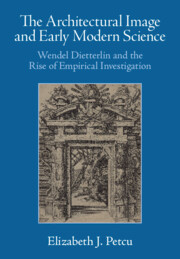 The Architectural Image and Early Modern Science
The Architectural Image and Early Modern Science Published online by Cambridge University Press: 29 November 2024
Dietterlin’s Architectura experienced perhaps its richest reception and afterlife among architectural sculptors in seventeenth-century colonial Peru. The façades of the Cathedral of Cuzco, Cuzco’s Jesuit Compañía church, and the monastery of the church of San Francisco in Lima all adapted motifs from Dietterlin’s Architectura to compare European and Indigenous Peruvian ideas about the stability of matter. Constructed in the wake of catastrophic earthquakes in the 1650s by Andean and other Indigenous sculptors, the façades reinterpret the structural, anatomical and material conceits of Dietterlin’s treatise to overturn its vision of architectural matter and especially stone as a materially unstable entity. Instead, they used the imagery of Dietterlin’s Architectura to promote an alternative ontology that underscored the transience of forms and structures while affirming the fixity of matter such as stone. Even as architectural images like those of the Architectura spurred artistic and natural philosophical discourses on a global scale, Peruvian artists adapted Dietterlin’s ideas to accommodate their own ontologies and philosophies of nature.
To save this book to your Kindle, first ensure [email protected] is added to your Approved Personal Document E-mail List under your Personal Document Settings on the Manage Your Content and Devices page of your Amazon account. Then enter the ‘name’ part of your Kindle email address below. Find out more about saving to your Kindle.
Note you can select to save to either the @free.kindle.com or @kindle.com variations. ‘@free.kindle.com’ emails are free but can only be saved to your device when it is connected to wi-fi. ‘@kindle.com’ emails can be delivered even when you are not connected to wi-fi, but note that service fees apply.
Find out more about the Kindle Personal Document Service.
To save content items to your account, please confirm that you agree to abide by our usage policies. If this is the first time you use this feature, you will be asked to authorise Cambridge Core to connect with your account. Find out more about saving content to Dropbox.
To save content items to your account, please confirm that you agree to abide by our usage policies. If this is the first time you use this feature, you will be asked to authorise Cambridge Core to connect with your account. Find out more about saving content to Google Drive.